In order to learn how to draw dresses, it is enough to break down a complex style into simple details, compare them with geometric shapes and connect everything together. And to make the dress believable, you need to add small details.

Instructions
Step 1
Think about what style of dress you would like to depict on the model. Imagine what it would look like if it were laid out on a plane. When you have decided what kind of dress you want to draw, what is the length of the sleeve, the neckline, the width of the skirt, mentally break the outfit into simple geometric shapes (circles, squares, ovals) and work out a schematic representation of the product. For example, the sleeves of a medieval dress can be represented as rectangles at the top, and from the elbow as isosceles trapezoids. The skirt can be depicted as a trapezoid or semicircle.
Step 2
Transfer the sketch of the dress to the model. Consider the natural bulges and concavities of the human body, the fullness or, conversely, the thinness of the person wearing this dress, the position of the arms, legs, neck. Erase the auxiliary pencil lines.
Step 3
Add folds to the fabric. Remember that they are located in places where there is tension in the material, or parts of the model's body are bent, for example, at the elbow, under the armpits, on the hem of the skirt if it is wide. Do not draw folds of fabric where they cannot be located. Do not try to draw all the smallest irregularities, just a few of the most important ones.
Step 4
Complement the dress with small decorative elements - ruffles, flounces, a belt, a bow, buttons. Remember that parts made from fabric also have folds, areas of tension and sagging.
Step 5
Color in the drawing. Remember that to create a believable image when painting, you need to select the part of the fold on which the shadow falls. Try to convey the texture of the material with the help of color, so that you can see that it is made from shiny satin or from soft wool. Keep in mind that since the body is voluminous, you will need to highlight areas of light, partial shade, shadow and reflex on the dress, otherwise the figure will look flat.






